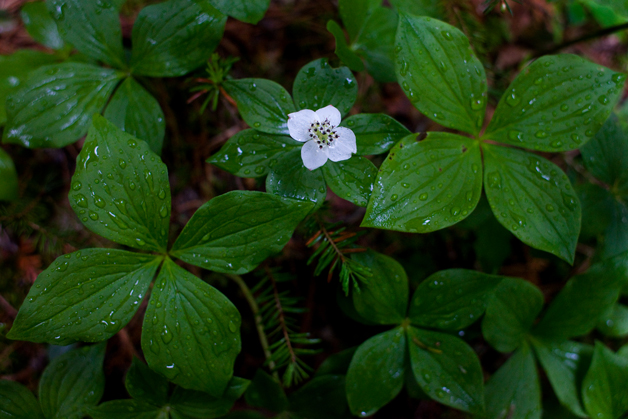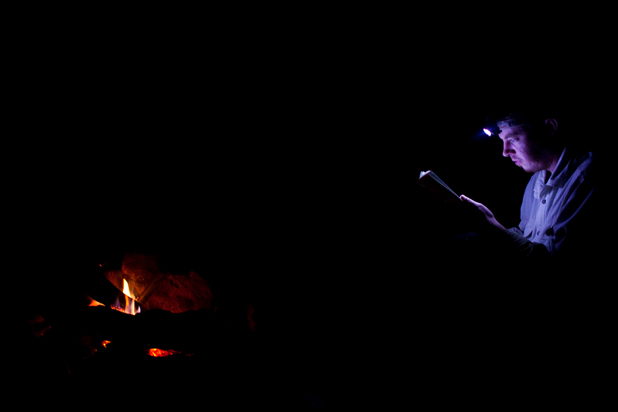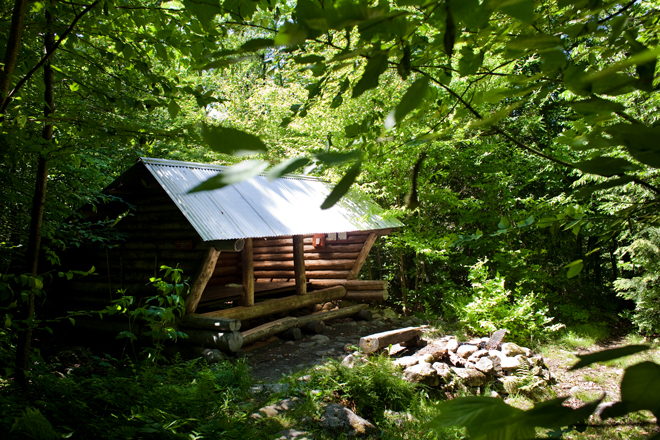Hundred Mile Wilderness
FEATURE-September 2010
By Christian Milneil
Photographs by Craig Dilger
About a twenty-mile walk from the nearest passable road, at the far western end of Pemadumcook Lake, a plain business card has been tacked to a tree with an arrow pointing down a rough side path. Follow this path for another mile, and you’ll eventually arrive at a dock, with nothing else nearby except for an air horn hanging from a tree. // I found this place at the end of a long, cold, wet day in early October. It was my fourth day of hiking through Maine’s Hundred-Mile Wilderness, the northernmost stretch of the Appalachian Trail between the town of Monson and Baxter State Park. As I peered through the heavy rain, it warmed my nearly hypothermic heart to see, on the opposite shore, the White House Landing Wilderness Camps, a century-old refuge for hunters, loggers, and hikers. The air horn summons an informal ferry service, which would take me to a hot shower, a bunkhouse with a woodstove, and a hiker-sized dinner with pie. // It had been two full days since I had seen another soul. I blasted the horn across the lake and waited.
Maine’s Hundred-Mile Wilderness is a huge, largely uninhabited region roughly bound by Route 11 to the east, Sebec Lake to the south, the Kokadjo Road to the west, and the Golden Road to the north. You could spend an entire day driving the logging roads that surround it—and this area composes only a small, southern peninsula of a forest that stretches from the suburbs of Bangor all the way to the Canadian border.
But the state’s wild northern woodland is also dotted with small, sometimes surprising outposts of hospitality, from turn-of-the-century camps that once catered to the robber barons of the Gilded Age to humble hunting cabins that have been handed down through generations of working-class Mainers.
“Eco-tourism” is a popular neologism that has entered discussions of northern Maine, but the concept behind it has existed at least since the nineteenth century, when Henry David Thoreau chronicled his excursions with the Penobscot guide Joe Polis in The Maine Woods.
A generation later, a forester named Benton MacKaye was wringing his hands at how many people were using their new automobiles to follow Thoreau into the nation’s scenic hinterlands—and bringing a sprawl of motels and souvenir shops with them. In a 1922 article, he proposed a greenbelt of farms, forests, and socialist work camps that would run along the mountainous fringes of the East Coast’s metropolitan areas and help contain their growth. His idea was more about social engineering than it was about recreation; he envisioned the proposed “Appalachian Trail” as a bulwark of the virtuous rural life against the roadside development he found so tacky.
Unlike most of MacKaye’s ideas, the trail concept caught on, albeit with significant departures from his vision. It wouldn’t include the mountain kibbutzim, and it proved to be fairly ineffectual against urban sprawl. If anything, it attracted even more people into the mountains to build summer houses and play miniature golf.
MacKaye’s original plan called for the trail to end on Mount Washington in New Hampshire, but a lawyer from Lubec prevailed in his efforts to extend it to Mount Katahdin. The Maine section does not attract a lot of day-trippers. At roughly 280 miles, it crosses fewer than a dozen paved roads in tiny towns such as Andover or Caratunk. The final stretch south of Baxter State Park is so isolated that it became known as the “Hundred-Mile Wilderness,” and eventually as a celebrated endurance challenge for hikers from all over the world.
This wilderness begins on the outskirts of Monson, the last chance for northbound hikers to pick up supplies before they reach Baxter State Park. Monson has a friendly, gypsy-camp vibe to it, a place where dreadlocked hikers and burly moose hunters can find common ground over lumberjack-sized breakfasts. The Appalachian Trail brings a lot of southerners to Maine, and they’ve noticeably influenced the town’s culture—there is a weekly bluegrass jam at the general store on Friday nights and a surprisingly good barbecue joint.
After a night at Shaw’s, a ramshackle but impeccably clean hikers’ hostel a block off of the Main Street, I strapped an eighty-pound pack to my back, kissed my wife good-bye, and set off on the trail near the base of Barren Mountain. This was about twenty miles into the Hundred-Mile Wilderness, leaving me with eighty miles to cover over the next six days. I would have no way to contact Jess or anyone else until I reached Abol Bridge at the southern edge of Baxter State Park, but we planned to meet there on Friday afternoon, and if I didn’t show up, she would send for help.
Aside from the absence of any telecommunications, the Hundred-Mile Wilderness is actually quite accessible to some. The region is still the home to large forestry operations, and dozens of logging roads crisscross the region. Hikers are just as likely to see a logging truck as a moose—that is to say, sightings of both are guaranteed. The roads also make the region accessible for day-trippers from the south, and new lodging options along the trail are attracting more hikers and cross-country skiers for weeklong vacations.
As I hiked over the Barren-Chairback Range on my second day, the sound of heavy machinery carried up from the valley near Long Pond. I sidetracked down from the trail to make a shortcut along the valley’s logging roads, and found that the noise wasn’t coming from a logging operation as I had assumed. Instead, I found a crew bulldozing a new road to the Appalachian Mountain Club’s newly acquired Gorman Chairback Camps, which are scheduled to reopen to the public in the summer of 2011.
The Boston-based Appalachian Mountain Club has bought thousands of acres of land around the Hundred-Mile Wilderness in recent years. Gorman Chairback is one of three historic hunting camps, connected by hiking and skiing trails, that the club has renovated to accommodate and nourish new guests. And on the other side of Barren Mountain, Maine Audubon rents its newly renovated lakeside lodges at its Borestone Mountain Sanctuary for group retreats and events. (Full disclosure: I began working for Maine Audubon a few weeks after completing this trip.) Both of these nonprofit conservation organizations aim to make the Hundred-Mile Wilderness accessible to more people.
During a break in the day’s showers, I ate lunch on the porch of Gorman Chairback’s dining hall, which looks out over the miles of wild shoreline girding Long Pond. While I made the short walk along logging roads back to the trail, a fully loaded logging truck rumbled down the road toward me. The ground shook as it went by, and the driver nodded at me from the cab—my final social interaction for that day.
I spent the rest of the afternoon in Gulf Hagas, the “Grand Canyon of Maine,” where a separate trail splits off to trace the rim of a deep slate canyon. The path scrambles over steep ledges, disquietingly close to steep drop-offs that plunges 200 feet down to the cold, churning West Branch of the Pleasant River. It’s probably the best place in the state to experience vertigo, something greatly enhanced when you simultaneously reflect on just how far away it is from the nearest trauma center.
Two more days of hiking through quiet woods brought me at last to the air horn at White House Landing. My arrival coincided with a particularly heavy downpour, and the owner was not pleased to come pick me up. On the opposite shore, he hustled me across the lawn to the hikers’ bunkhouse.
The shack was filled with the humid scents of eight thru-hikers, whose damp clothes hung thickly in the rafters and generated a small indoor weather system of their own. White House Landing maintains less-rustic accommodations for guests who bring more money and better hygiene, but the bunkhouse was affordable, warm, and out of the rain. And after three and a half days of hiking solo, I was pleased to have the company of other people.
In 1948, the first “thru-hiker” walked along its entire length from Georgia to Maine in a single summer. MacKaye dismissed it as a “stunt” that neglected the Trail’s higher social purpose. But the stunt caught on: every spring, thousands of people who share MacKaye’s romantic idea of the wilderness—and who have a few months to spare between jobs, spouses, or schools—set out from Georgia on their way to Mount Katahdin, and some, vice versa.
By the late summer and early fall, a much-diminished caravan of a few hundred hikers arrives in Maine for the last stretch of their journey. After months of hiking with one another, sharing in the unique and insular subculture of the woods, they can be difficult to persuade to talk about anything other than the trail and other thru-hikers. Still, the eight determined souls I met at White House Landing were a welcoming bunch. We swapped stories in the bunkhouse long into the night, and I began to feel like a part of the thru-hiker club myself.
I wound up walking with them for the rest of my trip. They included a fiftysomething father and his adult son, both of whom had been laid off the previous winter; a married woman in her early 30s who had already hiked the trail ten years before; a middle-aged guy from Lawrence who first hiked the trail two years ago during a sort of midlife crisis, who found that the crisis state suited him and had been hiking and camping on long wilderness trails ever since; two buddies—a builder and a porn-store clerk—from Dallas; a middle-aged woman from Austin, with her dog; and a guy who ghost-wrote entertaining hiking advice from “Hannah Montana” in trail registers along the way.
Two days later, the nine of us arrived at Abol Bridge, where the Golden Road crosses the West Branch of the Penobscot River next to an RV campground. Huge pickup trucks filled with partridge hunters rumbled by and stopped to rendezvous at the camp store. This was the anticlimactic end of the Hundred-Mile Wilderness.
We bought junk food and waited for our rides to town. The other hikers were tantalizingly close to the end of an even longer journey, but the significance of it was overshadowed by the more immediate concerns: they were mostly thinking about the comforts of Millinocket, with its laundry, showers, and food. For my part, I was looking forward to seeing my wife again, and climbing into the warm, clean, and dry clothes she would bring me.
The next day, we joined several other visiting friends for a climb up Katahdin. The weather was the same as it had been all week: fog and rain, which turned to wind-driven sleet on the alpine plateau near the top. The dry clothes that Jess had brought became soaked, then frozen.
But on our way down, right before our group descended below the tree line, a gust of wind suddenly cleared away the clouds. All at once, the vast forest across which I had trekked over the past week lay spread out below us under remnant wisps of valley fog: wrinkled piles of mountain ridges streaked with yellow birches, red sugar maples, boreal greens, and shimmering ponds.
From up here, it certainly looked like a wilderness. But that name glosses over the complexities of this landscape: it’s a solitary place populated with personable people, and a wild place entangled in the often oppositional industries of tourism and forestry.
Thoreau reminds us that “no part of the earth is so low that the heavens may not be seen from it, and we have only to stand on the summit of our hour to command an uninterrupted horizon.” I was going back to the city—to running water, an office, and daily errands. But with me would come a more revealed understanding of the wild frontier soul of Maine.”












